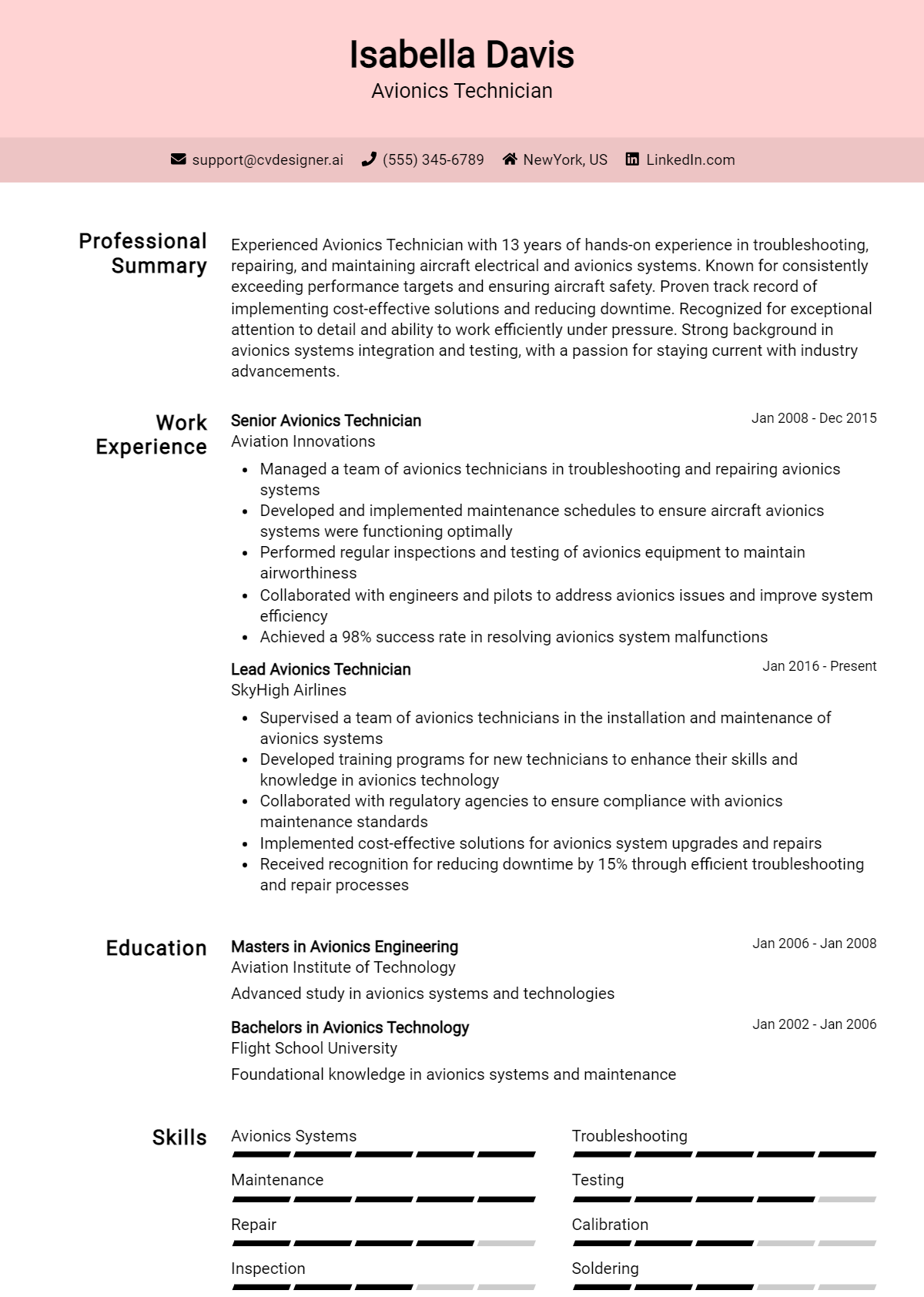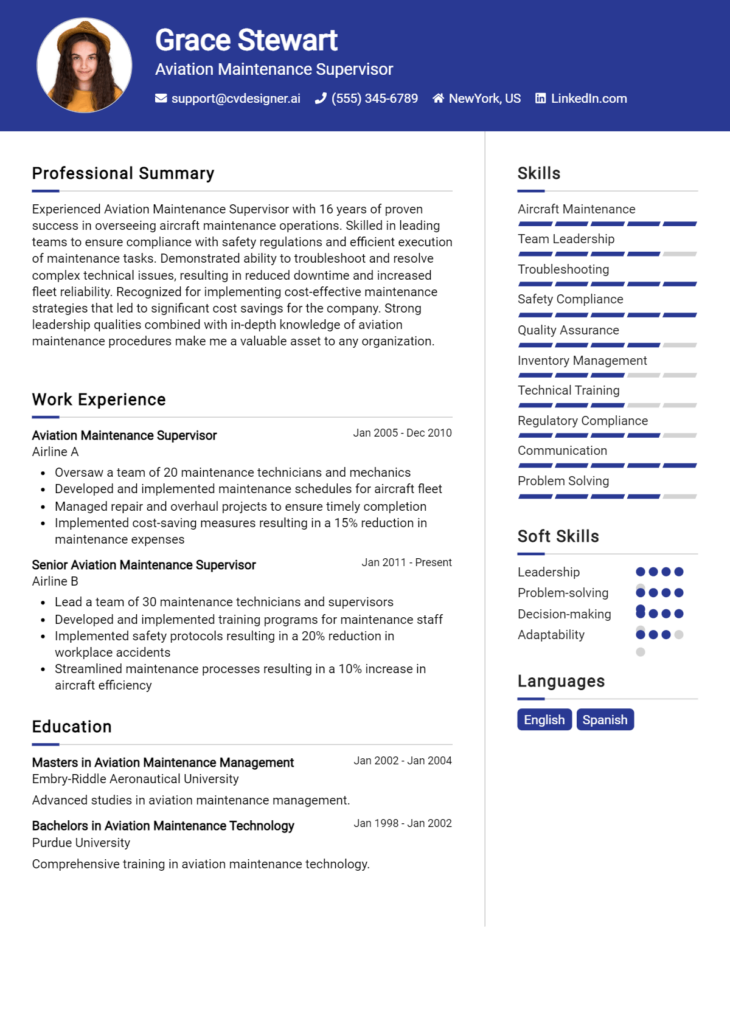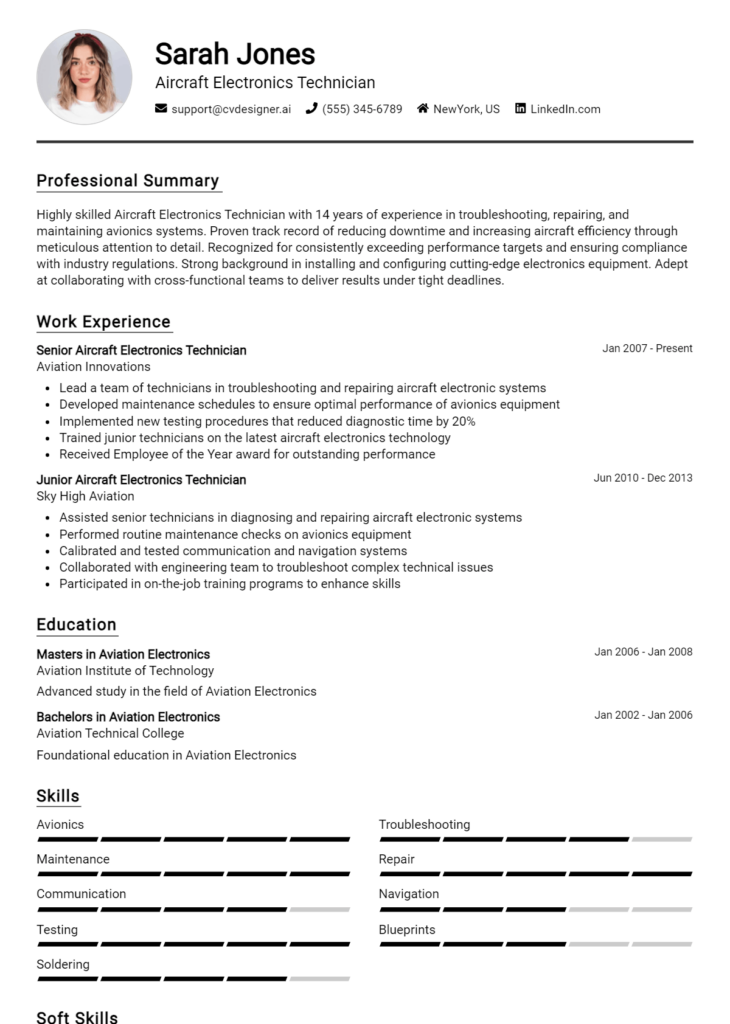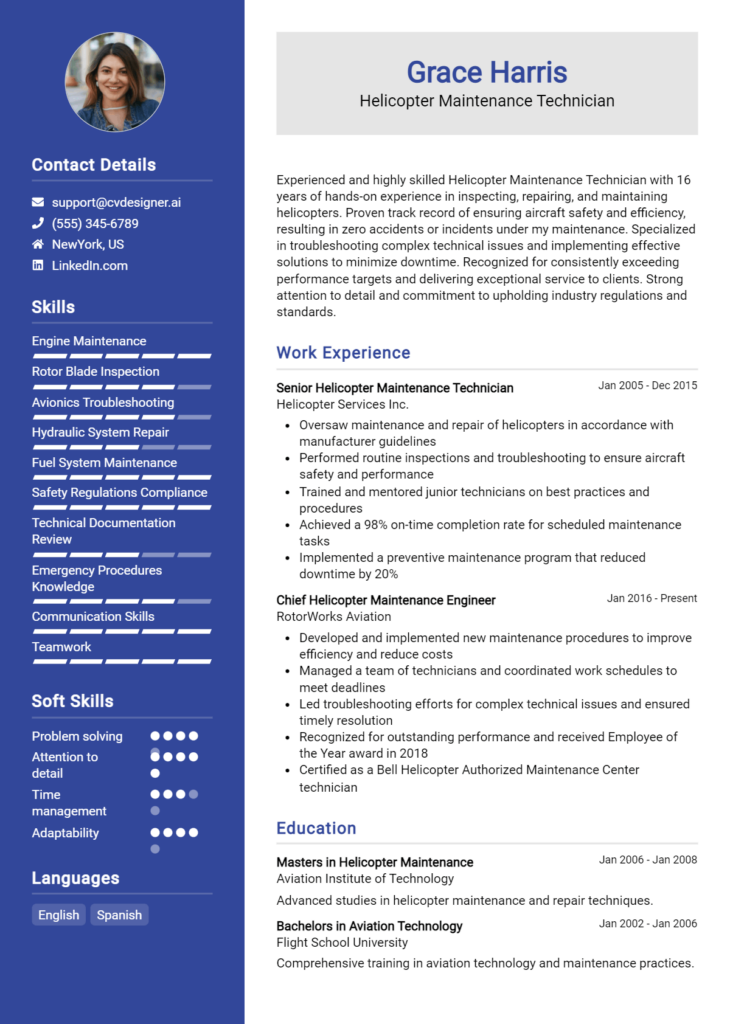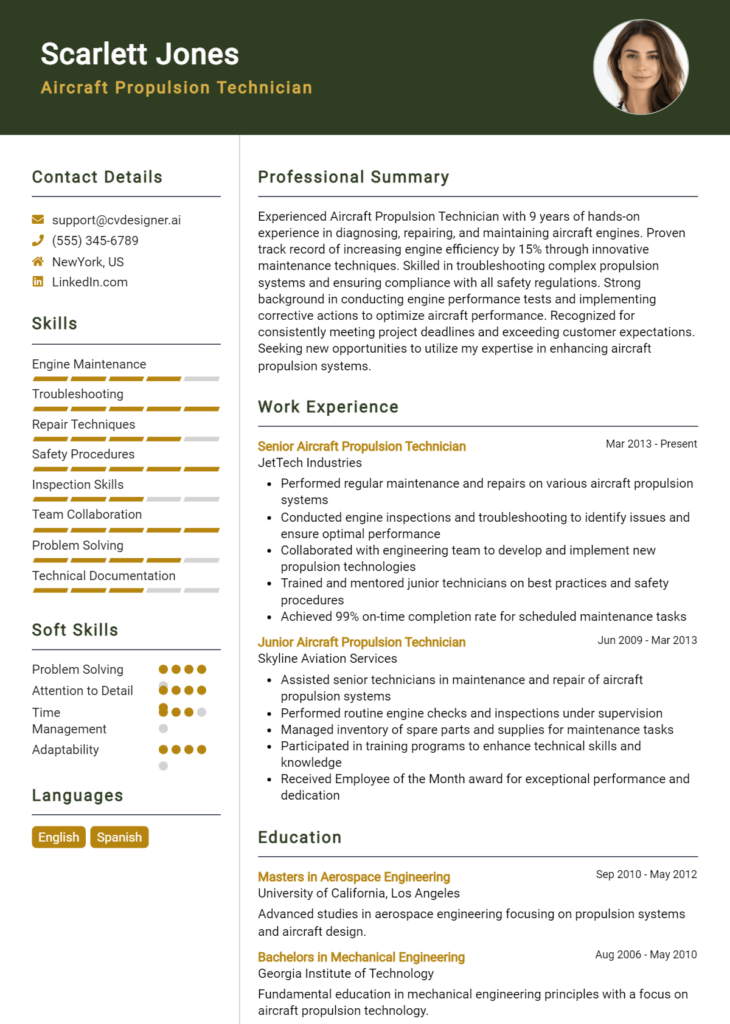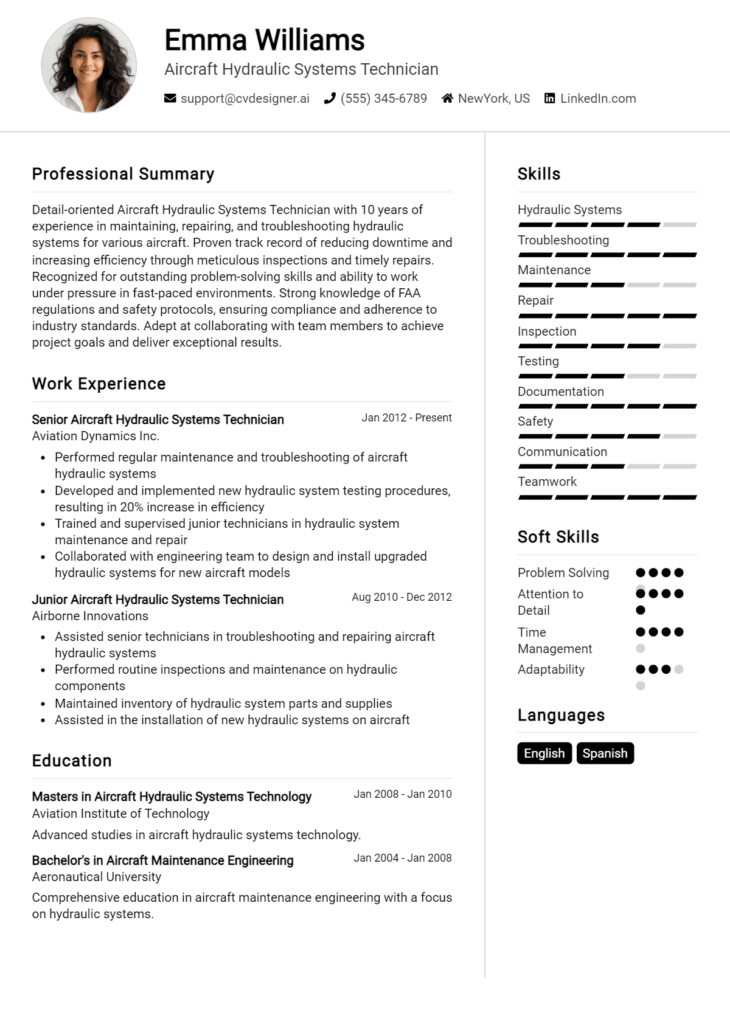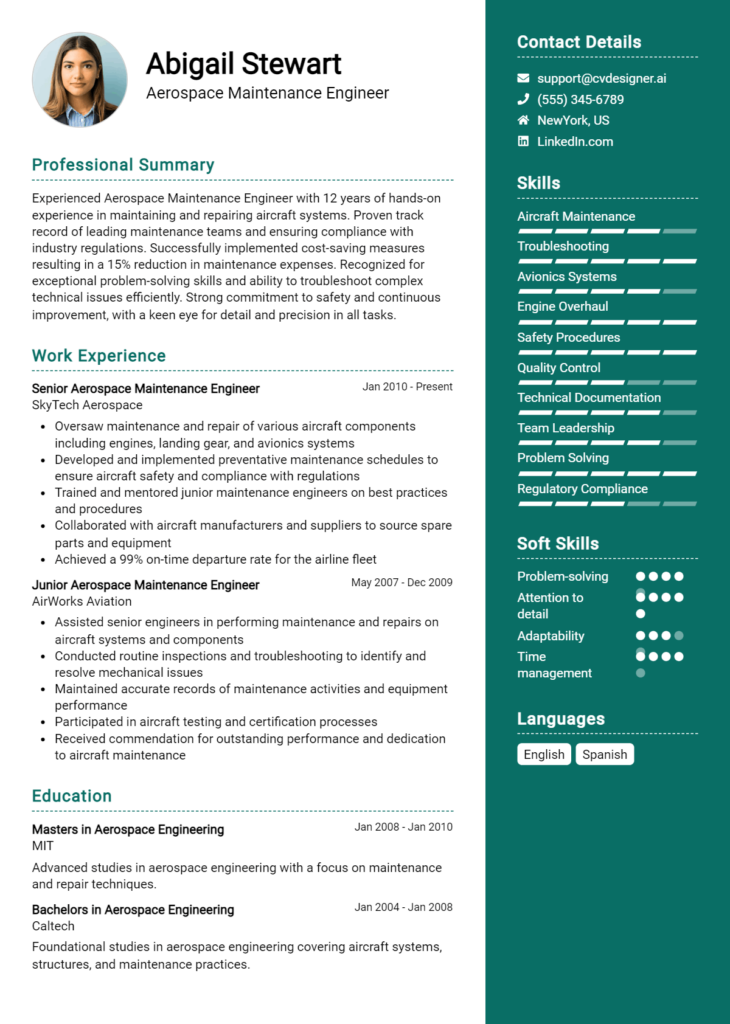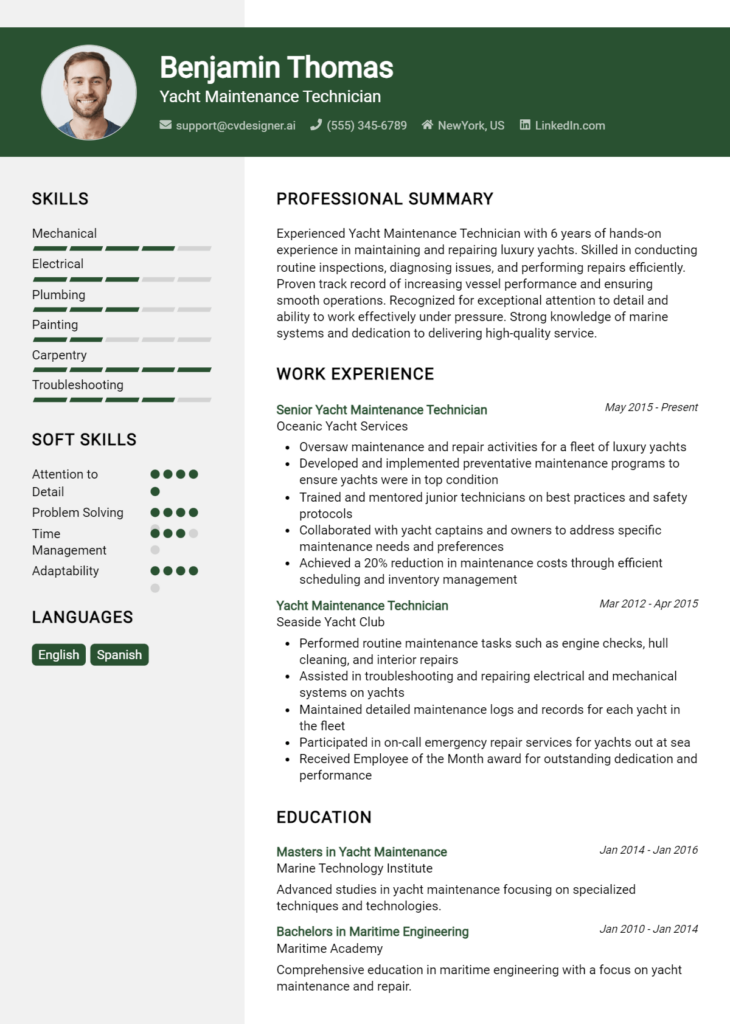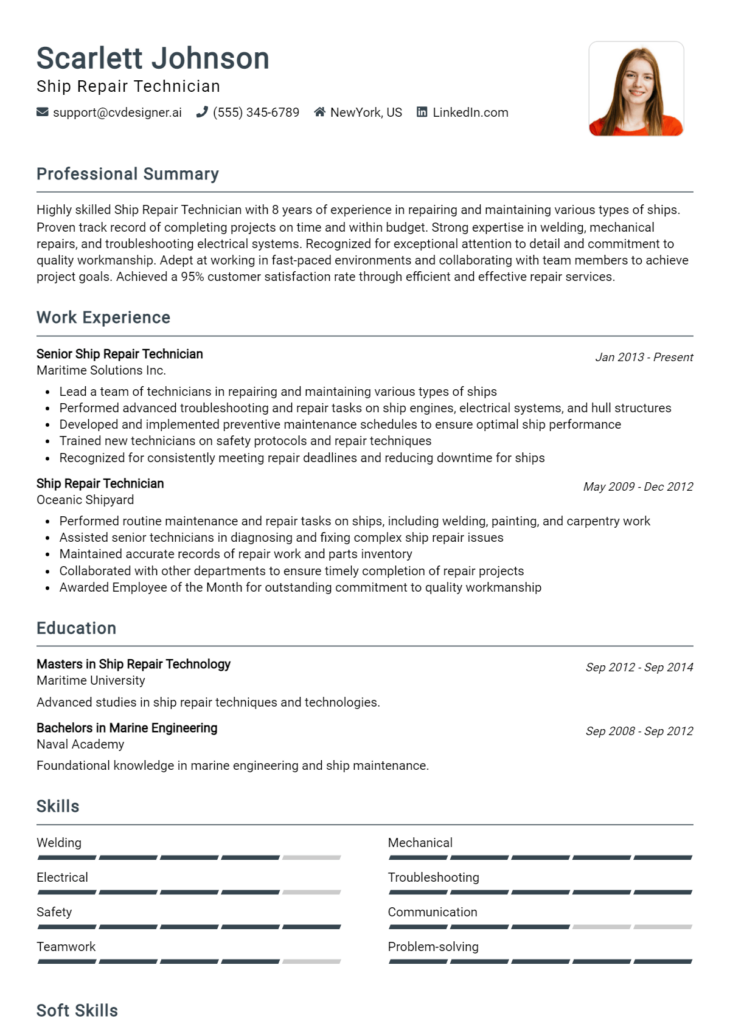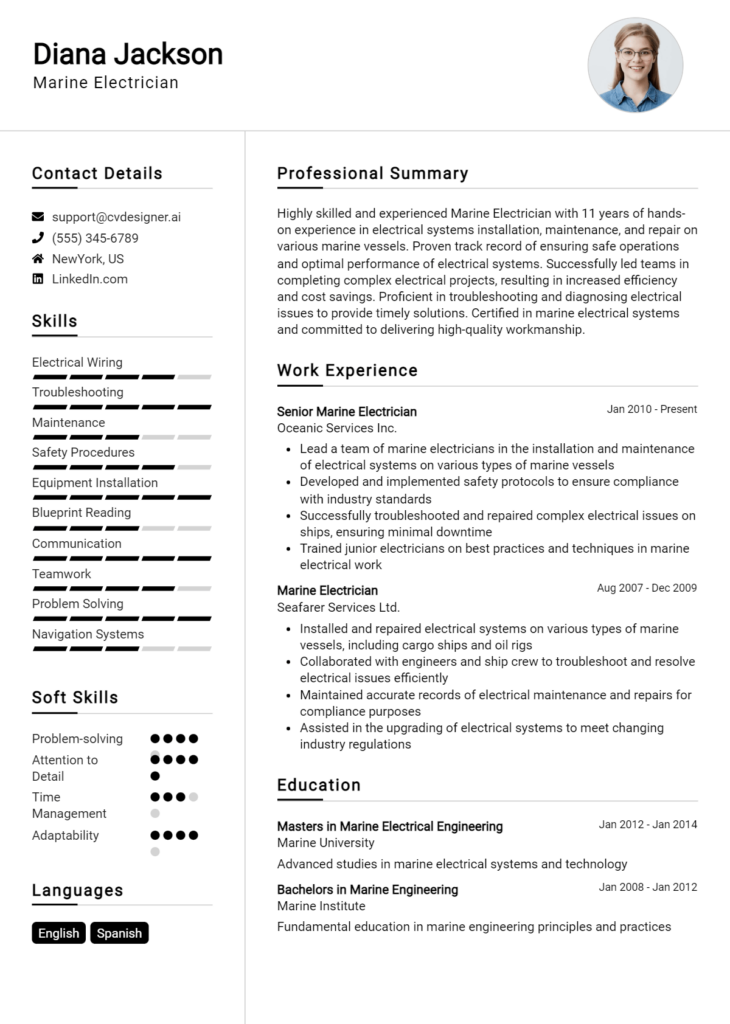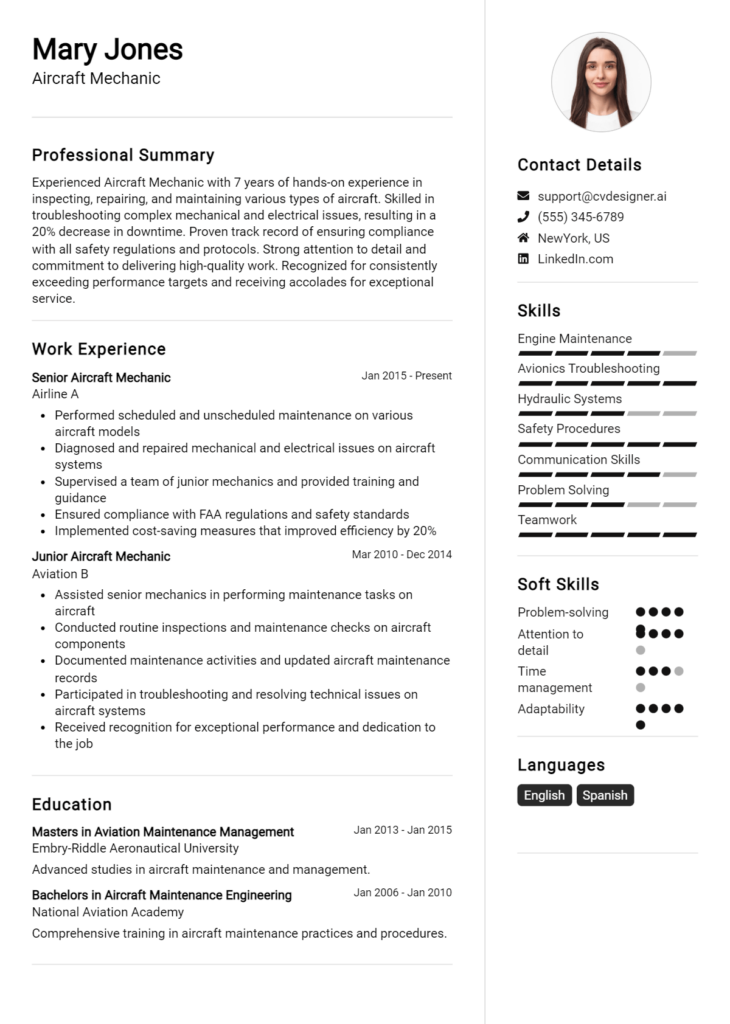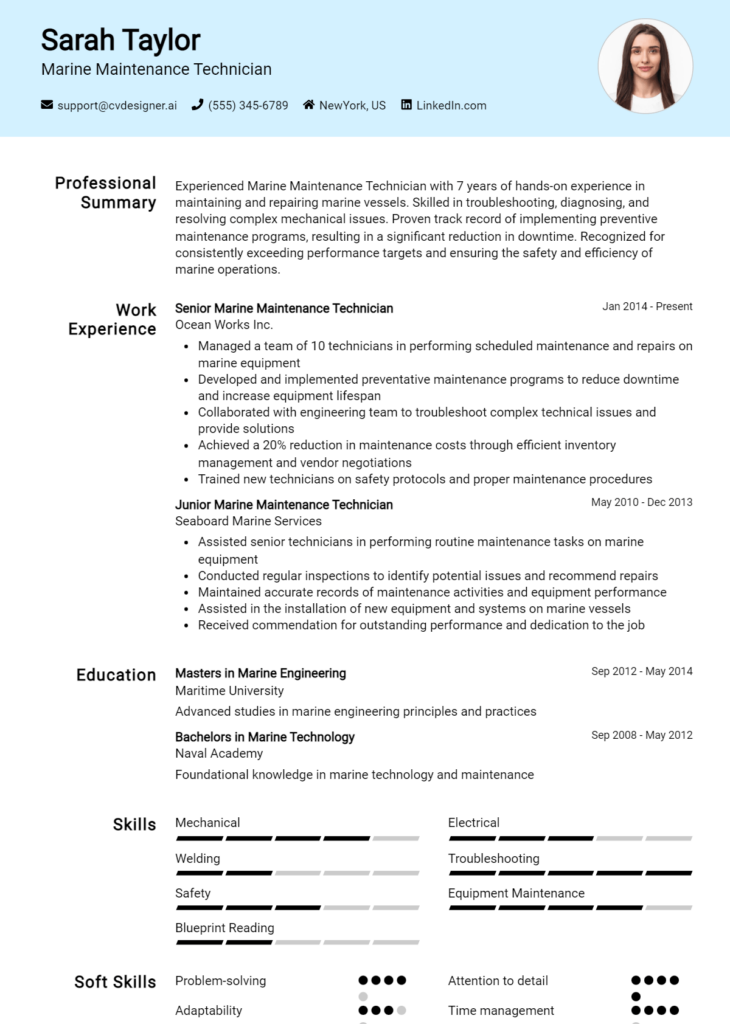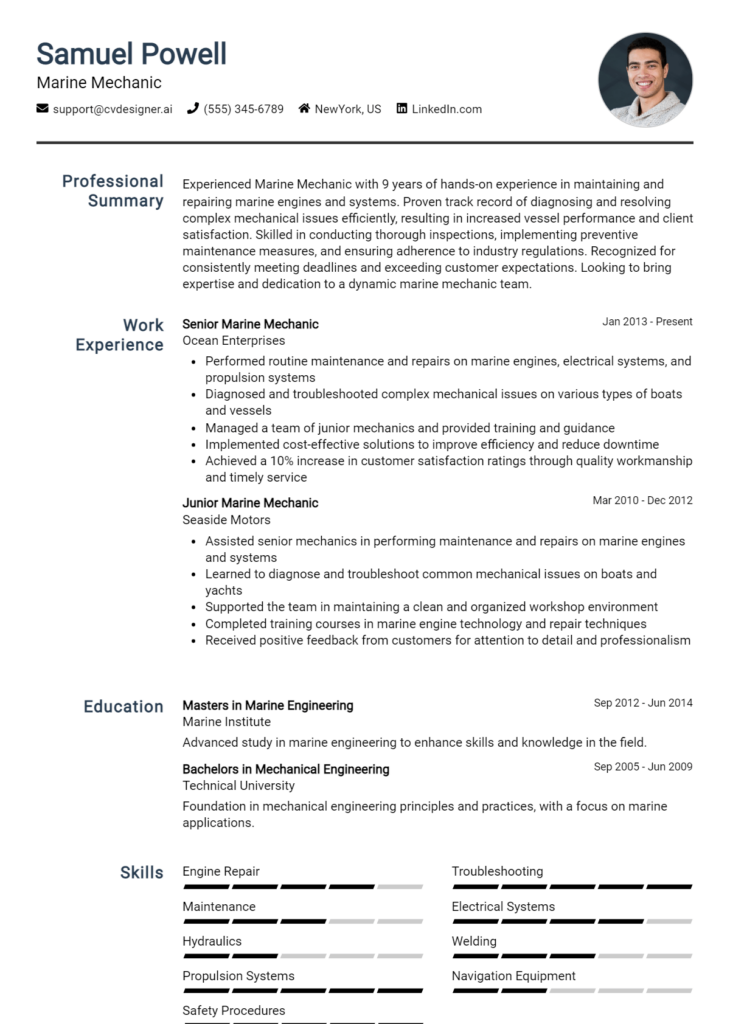Avionics Technician Core Responsibilities
Avionics Technicians play a crucial role in the aerospace industry, responsible for the installation, maintenance, and repair of complex electronic systems used in aircraft and spacecraft. They bridge various departments, collaborating with engineering, operations, and safety teams to ensure optimal performance and compliance with regulations. Essential skills include technical proficiency, operational knowledge, and advanced problem-solving abilities. These competencies are vital for achieving organizational goals. A well-structured resume can effectively showcase these qualifications, enhancing job prospects.
Common Responsibilities Listed on Avionics Technician Resume
- Conduct regular inspections and preventive maintenance on avionics systems.
- Troubleshoot and repair electrical systems and components.
- Install and calibrate avionics equipment, ensuring compliance with safety standards.
- Read and interpret technical manuals and schematics.
- Document maintenance procedures and repair logs accurately.
- Collaborate with engineers to enhance system performance.
- Test and evaluate avionics systems for functionality and reliability.
- Utilize diagnostic tools and software for troubleshooting electronic issues.
- Stay updated on industry regulations and advancements in technology.
- Train junior technicians on best practices and safety protocols.
High-Level Resume Tips for Avionics Technician Professionals
In the competitive field of avionics, a well-crafted resume is essential for professionals seeking to make a strong first impression on potential employers. Your resume is often the first point of contact between you and a hiring manager, and it needs to effectively convey not only your technical skills but also your achievements in the industry. It should serve as a powerful marketing tool that showcases your qualifications and demonstrates your value as an Avionics Technician. This guide will provide practical and actionable resume tips specifically tailored for Avionics Technician professionals, ensuring you stand out in a crowded job market.
Top Resume Tips for Avionics Technician Professionals
- Tailor your resume to match the job description, using keywords and phrases that reflect the specific requirements of the position.
- Highlight relevant experience, including previous roles in avionics maintenance, troubleshooting, and repair, to demonstrate your hands-on skills.
- Quantify your achievements whenever possible, such as the number of aircraft serviced or the reduction in downtime due to your interventions.
- Showcase industry-specific certifications and training, such as FAA certifications or specialized avionics courses, to emphasize your qualifications.
- Include a summary statement at the top of your resume that encapsulates your core competencies and career goals in avionics.
- Use action verbs to describe your responsibilities and accomplishments, creating a dynamic and engaging narrative of your professional experience.
- Incorporate technical skills relevant to avionics, such as knowledge of specific systems, software, and tools, to highlight your expertise.
- Keep the format clean and professional, ensuring that your resume is easy to read and visually appealing.
- Limit your resume to one or two pages, focusing on the most relevant and recent experiences to keep the hiring manager's attention.
- Proofread carefully to eliminate any errors, as attention to detail is crucial in the avionics field.
By implementing these tips, you can significantly increase your chances of landing a job in the Avionics Technician field. A polished and focused resume that effectively showcases your skills and achievements will resonate with employers, setting you apart from other candidates and paving the way for a successful career in avionics.
Why Resume Headlines & Titles are Important for Avionics Technician
In the competitive field of avionics, a resume's headline or title serves as a critical first impression that can set the tone for the entire application. For an Avionics Technician, a strong headline immediately captures the attention of hiring managers, providing a snapshot of the candidate's key qualifications in just a few impactful words. A well-crafted headline should be concise, relevant, and directly related to the job being applied for, effectively summarizing the technician's skills, experience, and accomplishments. This strategic approach not only highlights the candidate's value but also aligns their expertise with the expectations of the role, increasing the likelihood of securing an interview.
Best Practices for Crafting Resume Headlines for Avionics Technician
- Keep it concise: Aim for a headline that is no longer than 10-12 words.
- Be role-specific: Tailor your headline to reflect the specific position of Avionics Technician.
- Highlight key skills: Incorporate essential skills or certifications relevant to the job.
- Use action-oriented language: Start with strong verbs to convey your capabilities.
- Include quantifiable achievements: Whenever possible, mention specific accomplishments or metrics.
- Reflect your experience level: Indicate whether you are an entry-level, mid-career, or senior technician.
- Avoid jargon: Use clear language that is easily understood by hiring managers.
- Make it memorable: Aim for a unique phrase that distinguishes you from other candidates.
Example Resume Headlines for Avionics Technician
Strong Resume Headlines
Experienced Avionics Technician with 5+ Years in Aircraft Maintenance
Certified Avionics Specialist Skilled in Troubleshooting and Repair
Detail-Oriented Avionics Technician with Proven Track Record in Quality Assurance
Results-Driven Avionics Technician with Expertise in Avionics Systems Integration
Weak Resume Headlines
Looking for a Job in Aviation
Technician with Some Experience
Avionics Technician
The strong headlines are effective because they are specific, clearly articulating the candidate's expertise and accomplishments while directly relating to the role of an Avionics Technician. They create a strong first impression that can pique the hiring manager's interest. In contrast, the weak headlines fail to impress due to their vagueness and lack of detail, making it difficult for employers to gauge the candidate's suitability for the position. A generic title does not communicate any unique selling points, which can lead to the candidate being overlooked in favor of more compelling applicants.
Writing an Exceptional Avionics Technician Resume Summary
Writing a compelling resume summary is crucial for an Avionics Technician, as it serves as the first impression to potential employers. A strong summary quickly captures the attention of hiring managers by highlighting key skills, experience, and accomplishments that are directly relevant to the job role. It should be concise yet impactful, effectively summarizing the candidate's qualifications in a way that aligns with the specific job they are applying for. A well-crafted resume summary not only showcases technical expertise but also demonstrates how the technician can add value to the organization.
Best Practices for Writing an Avionics Technician Resume Summary
- Quantify achievements: Use numbers and metrics to demonstrate your impact and effectiveness.
- Focus on skills: Highlight technical skills and competencies that are essential for the role.
- Tailor the summary: Customize your summary for each job application to align with the job description.
- Keep it concise: Aim for 2-4 sentences that summarize your qualifications without unnecessary detail.
- Use action verbs: Start sentences with strong action verbs to convey confidence and initiative.
- Highlight relevant experience: Include specific experiences that showcase your qualifications for the role.
- Showcase certifications: Mention any relevant certifications or training that enhance your candidacy.
- Convey passion: Express a genuine interest in the field and enthusiasm for the role.
Example Avionics Technician Resume Summaries
Strong Resume Summaries
Detail-oriented Avionics Technician with over 5 years of experience maintaining and troubleshooting avionics systems in commercial aircraft. Reduced maintenance turnaround time by 20% through effective diagnostics and timely repairs, ensuring safety and compliance with FAA regulations.
Dedicated Avionics Technician with extensive knowledge of flight control systems and navigation equipment. Achieved a 95% success rate in troubleshooting avionics issues, contributing to a 30% decrease in unscheduled maintenance events for a fleet of 50 aircraft.
Skilled Avionics Technician with a proven track record in performing complex installations and repairs on avionics systems. Successfully led a team project that upgraded avionics technology, enhancing operational efficiency by 15% and minimizing system downtimes.
Weak Resume Summaries
Experienced technician with skills in avionics. I have worked on various aircraft systems and can help improve operations.
Avionics Technician with a background in electronics and maintenance. I am looking for a job where I can use my skills.
The examples provided illustrate the difference between strong and weak resume summaries. Strong summaries effectively quantify achievements, use specific terminology related to the avionics field, and directly align with the desired qualifications for the role. In contrast, weak summaries lack detail, are overly generic, and fail to convey any measurable impact or relevance, making them less compelling to hiring managers.
Work Experience Section for Avionics Technician Resume
The work experience section of an Avionics Technician resume is critical as it serves as a testament to the candidate's technical skills, problem-solving abilities, and capacity to deliver high-quality results in a demanding field. This section allows potential employers to gauge how effectively a candidate has applied their expertise in real-world scenarios, highlighting their ability to manage teams and collaborate with other professionals. By quantifying achievements and aligning experiences with industry standards, candidates can significantly enhance their appeal, showcasing not just what they have done, but the impact of their contributions on previous projects and organizations.
Best Practices for Avionics Technician Work Experience
- Use specific technical terminology relevant to avionics systems and components.
- Quantify achievements with metrics such as reduced downtime, increased efficiency, or cost savings.
- Highlight collaborative projects that demonstrate teamwork and communication skills.
- Tailor experiences to align with the job description and requirements of the position you are applying for.
- Include certifications and specific technical skills that are relevant to the roles held.
- Showcase leadership roles or responsibilities that illustrate your ability to manage teams effectively.
- Describe challenges faced and solutions implemented to show problem-solving capabilities.
- Use action verbs to convey a sense of initiative and proactivity in your work.
Example Work Experiences for Avionics Technician
Strong Experiences
- Led a team of 5 technicians in the installation of advanced avionics systems on a fleet of 20 aircraft, resulting in a 30% reduction in operational downtime.
- Developed and implemented a maintenance program that improved system reliability by 25%, contributing to a 15% decrease in maintenance costs over two years.
- Collaborated with engineers to troubleshoot and resolve complex avionics issues, achieving a 95% first-time fix rate on repairs.
- Trained junior technicians on the latest avionics technologies, enhancing team performance and reducing onboarding time by 40%.
Weak Experiences
- Responsible for working on avionics systems in various aircraft.
- Assisted in the maintenance of equipment and repairs.
- Participated in team meetings and discussions about avionics issues.
- Performed routine checks on aircraft systems as part of job duties.
The examples labeled as strong illustrate specific accomplishments and quantifiable results, showcasing not only technical expertise but also leadership and collaboration skills. In contrast, the weak experiences lack detail and fail to convey the candidate's impact or contributions, making them less compelling to potential employers. Strong experiences effectively highlight the value a technician can bring to an organization, while weak experiences leave too much to interpretation, failing to impress hiring managers.
Education and Certifications Section for Avionics Technician Resume
The education and certifications section of an Avionics Technician resume is crucial in establishing the candidate's academic foundation and industry expertise. This section not only showcases formal education but also highlights relevant certifications and specialized training, which are essential in a field where technological advancements are constant. By detailing relevant coursework and certifications, candidates can significantly enhance their credibility and demonstrate a commitment to continuous learning, making them more appealing to potential employers in the aerospace industry.
Best Practices for Avionics Technician Education and Certifications
- Include only relevant degrees and certifications that pertain to avionics or aircraft maintenance.
- Specify the level of education (e.g., Associate's, Bachelor's) and the name of the institution.
- Highlight industry-recognized certifications, such as FAA Airframe and Powerplant (A&P) certification.
- Detail any specialized training or workshops related to avionics technology.
- List relevant coursework that aligns with the job requirements, emphasizing technical skills.
- Keep the information up to date, removing any outdated certifications or degrees.
- Include the year of completion for degrees and certifications to demonstrate recent qualifications.
- Organize this section to prioritize the most impactful and relevant qualifications first.
Example Education and Certifications for Avionics Technician
Strong Examples
- Associate Degree in Avionics Technology, XYZ Technical College, Graduated May 2022
- FAA Airframe and Powerplant (A&P) Certification, Issued April 2023
- Certification in Aviation Maintenance Technology, ABC Aviation School, Completed June 2021
- Coursework in Digital Avionics Systems, Control Systems, and Aircraft Electrical Systems
Weak Examples
- Bachelor's Degree in Business Administration, Graduated 2018
- Certification in Computer Programming, Completed 2015
- High School Diploma, Graduated 2000
- Certification in General Office Management, Completed 2010
The strong examples are considered effective because they directly relate to the skills and knowledge required for an Avionics Technician role. They showcase recent and relevant education and certifications that align with industry standards. Conversely, the weak examples are ineffective due to their lack of relevance to the avionics field, highlighting educational qualifications and certifications that do not contribute to the candidate's suitability for the position. This distinction underscores the importance of tailoring the education and certifications section to the specific demands of the job role.
Top Skills & Keywords for Avionics Technician Resume
As an Avionics Technician, possessing the right skills is crucial for effectively performing your duties and ensuring the safety and functionality of aircraft systems. A well-crafted resume that highlights both hard and soft skills can significantly increase your chances of landing an interview. Employers seek candidates who not only have the technical expertise to troubleshoot and repair complex avionics systems but also possess the interpersonal skills necessary to work collaboratively within a team. By showcasing these skills, you can demonstrate your capability and readiness to contribute to the aviation industry.
Top Hard & Soft Skills for Avionics Technician
Soft Skills
- Attention to Detail
- Problem-Solving Skills
- Effective Communication
- Team Collaboration
- Time Management
- Adaptability
- Critical Thinking
- Customer Service Orientation
- Initiative
- Self-Motivation
Hard Skills
- Knowledge of Avionics Systems
- Proficiency in Electrical Systems
- Experience with Testing Equipment
- Familiarity with Aviation Regulations
- Ability to Read Schematics
- Troubleshooting Skills
- Software Proficiency (e.g., ARINC, DO-178)
- Wiring and Soldering Techniques
- Use of Diagnostic Tools
- Equipment Calibration
For a comprehensive understanding of how to present your skills and work experience effectively, be sure to explore additional resources that can guide you in creating a standout resume.
Stand Out with a Winning Avionics Technician Cover Letter
Dear Hiring Manager,
I am writing to express my interest in the Avionics Technician position at [Company Name], as advertised on [Job Board/Company Website]. With a solid background in avionics systems and a passion for aviation technology, I am confident in my ability to contribute effectively to your team. My extensive training in electronics and hands-on experience with aircraft systems have equipped me with the skills necessary to troubleshoot, repair, and maintain complex avionics systems in compliance with FAA regulations.
During my previous role at [Previous Company Name], I successfully completed numerous projects that involved the installation, testing, and maintenance of avionics equipment. I have a keen eye for detail, which has allowed me to identify issues before they escalate, ensuring the safety and reliability of aircraft operations. Additionally, my ability to work collaboratively with engineers and other technicians has enhanced our team's efficiency, leading to a significant reduction in turnaround times for aircraft servicing.
I am particularly drawn to the opportunity at [Company Name] because of its commitment to innovation and excellence in aviation. I admire your dedication to staying at the forefront of technology, and I am eager to bring my expertise in avionics to help maintain and advance your fleet. I am excited about the possibility of contributing to projects that not only enhance aircraft performance but also improve safety and operational efficiency.
Thank you for considering my application. I look forward to the opportunity to discuss how my skills and experiences align with the needs of your team. I am eager to bring my technical knowledge and passion for aviation to [Company Name] and help achieve its mission of delivering exceptional service.
Sincerely,
[Your Name]
[Your Contact Information]
Common Mistakes to Avoid in a Avionics Technician Resume
When crafting a resume for an Avionics Technician position, it's crucial to present your skills and experiences effectively to stand out in a competitive field. However, many applicants make common mistakes that can hinder their chances of landing an interview. By avoiding these pitfalls, you can ensure that your resume highlights your qualifications and sets the right tone for your application.
Using a Generic Template: Many candidates rely on one-size-fits-all templates that fail to showcase their unique skills and experiences relevant to avionics. Customizing your resume to reflect your specific qualifications is essential.
Neglecting Technical Skills: Avionics technicians require a robust set of technical skills. Failing to list relevant certifications, equipment familiarity, and software proficiency can make your resume less appealing to employers.
Vague Job Descriptions: Providing unclear or overly broad descriptions of past job responsibilities can leave hiring managers confused. Be specific about your achievements and the tasks you performed in each role.
Ignoring Industry Jargon: The aviation industry has its own language and terminology. Not incorporating relevant industry jargon can make your resume less impactful and may suggest you lack the necessary knowledge.
Overloading with Irrelevant Information: Including unrelated work experience or excessive details about non-technical roles can dilute the focus of your resume. It's vital to keep your content relevant to avionics.
Poor Formatting: A cluttered or poorly organized resume can detract from your qualifications. Ensure your resume is clean, easy to read, and logically structured for better readability.
Failing to Quantify Achievements: When applicable, use numbers and metrics to quantify your accomplishments, such as the number of aircraft serviced or the percentage of error reduction achieved. This provides concrete evidence of your capabilities.
Not Tailoring for Each Job Application: Sending the same resume for multiple positions can be detrimental. Tailoring your resume for each application by aligning your skills and experiences with the job requirements can significantly improve your chances of getting noticed.
Conclusion
As an Avionics Technician, you play a crucial role in ensuring the safety and efficiency of aircraft systems. Your expertise in troubleshooting, maintaining, and repairing complex electronic systems is invaluable in the aviation industry. Throughout this article, we've highlighted the essential skills and qualifications needed for success in this role, including proficiency in avionics systems, familiarity with aviation regulations, and strong problem-solving abilities.
It's essential to present these skills effectively in your resume, as a well-crafted document can significantly enhance your job prospects. Remember to tailor your resume to showcase your technical skills, relevant experience, and any certifications you may hold.
Now is the perfect time to review and update your Avionics Technician resume to reflect your qualifications accurately. Utilize helpful tools like resume templates, which provide a polished design to make your resume stand out. Consider using a resume builder for an easy and efficient way to create a custom resume that highlights your strengths. You can also explore resume examples for inspiration and guidance on how to structure your document effectively. Additionally, don't forget the importance of a strong first impression with a captivating cover letter using our cover letter templates.
Take charge of your career today by ensuring that your resume reflects the best version of you!

